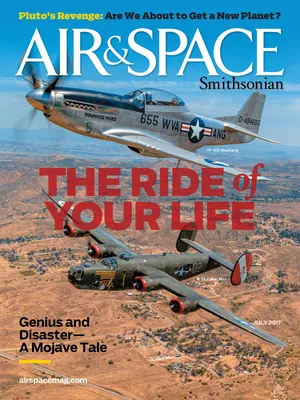When Birds Hit Aircraft
A forensic ornithologist helps investigate bird strikes.
:focal(537x205:538x206)/https://tf-cmsv2-smithsonianmag-media.s3.amazonaws.com/filer/2d/c9/2dc91d90-d022-4918-9053-947c28c0ef95/33a_jj2017_nhb2011-00060-wr.jpg)
Carla J. Dove is the manager of the Feather Identification Lab at the Smithsonian Institution’s National Museum of Natural History in Washington, D.C. She and her staff identify the types of birds that collide with military and civil aircraft. She spoke with senior associate editor Diane Tedeschi in April.
Air & Space: When you receive a sample from a bird strike, what happens next?
Dove: The first part of the process involves just looking at the sample and trying to decide what would be the best way to do the identification. If it’s a sample of whole feathers, we have some color and we have some pattern and we have some texture. Although there are 10,000 species of birds, only about 500 have been involved in bird strikes. And of those 500, probably only about 100 are common. So if the feather has a fluffy base and it’s sort of pinkish in color, we know it could be a dove. So we will take the whole feather sample and try to match it with specimens in the museum collections. If we have whole feathers, it’s a process of elimination. If we get a sample that we don’t have a clue what bird it is because it’s just a brown feather—there’s lots of birds that have brown feathers—then we look at the microscopic structure of the feather. We will make a micro-slide, and examine it under a light microscope. We have a collection of micro-slides representing known bird species. We have a comparison microscope, and we will take the unknown sample and put it on one stage and put the known sample that we think it is on the other stage and compare those two until we get a match.
How many military aircraft experienced bird strikes in 2016?
It’s approximately 5,000 a year for the military, and it’s about 10,000 a year for civil aviation. The military is required to report all incidents, and they are supposed to send in remains from every bird strike. With civil aviation, the reporting is voluntary. So even though they report over 10,000 strikes, we don’t receive remains for even half of those.
What are the top five bird species involved in strikes with aircraft?
The top five, in terms of number of incidents, will be small birds like horned larks and mourning doves. Damage-wise would be large birds such as hawks and water fowl. But small birds can also cause damage, especially flocks of them, such as starlings or blackbirds. We had a case once where a robin did $500,000 worth of damage because it hit a lamp on the airplane, and then the lamp went into the engine and caused problems.
Outside of the Smithsonian’s Museum of Natural History, do you know of other people who do this kind of work?
Well, the microscopic part of the work is where we are so unique. Having the ability to look at the microscopic structures of feathers and identify the group of birds it belongs to is what puts us above everybody else. Now there is a lab in Ashland, Oregon— the U.S. Fish and Wildlife lab—and they do a lot of identifications based on whole feathers. [The samples come from] something that is poached—a federal crime. They don’t do any non-federal cases. A few other people in the world we have trained to do microscopic work: There’s a person in Israel, and there is a person in England. But no one has the case load that we have.
Are the people in Israel and England also doing the identifications for bird strikes?
Yes.
Of the four military services, would you say you do the most business with the Air Force?
Yes. We have an interagency agreement with the Air Force and the Navy. We don’t have any agreements with the Army yet. But the Army does a lot of helicopter flying. So we’re wondering when we’re going to be asked to help the Army too. We have the resources—so it’s just a matter of time until we start working with them.
How are the samples sent to you?
If they’re dry remains, they can be sealed and packaged in envelopes and sent to us through the mail. If it’s a sample that maybe has some tissue or some fresh remains, they may sometimes freeze it and put it in a cooler and ship it to us by FedEx.
Do you have a favorite bird?
Well, I mean birds are the most beautiful creatures on Earth. They have the most wonderful plumages and just so much variation and diversity. It’s really hard to pick a favorite bird as far as beauty goes. But one of the birds I admire most is a turkey vulture—and people are like, what? But it’s an amazing bird in that it gets up late, flies on thermals, and goes around cleaning up the Earth of all the carrion. I just like to watch them soar. They’re not that beautiful, but. Now they also cause a lot of damage to airplanes because they fly at that same level where the military do a lot of touch-and-go [flights]. We see a lot of turkey vultures in our lab.
What do you like most about your job?
In addition to just loving birds and always being interested in birds, I think solving puzzles is what keeps us interested in what we’re doing. There’s also a great deal of satisfaction in knowing that you’re helping to improve aviation safety. We get calls from military people all the time thanking us for what we do and for helping them.
